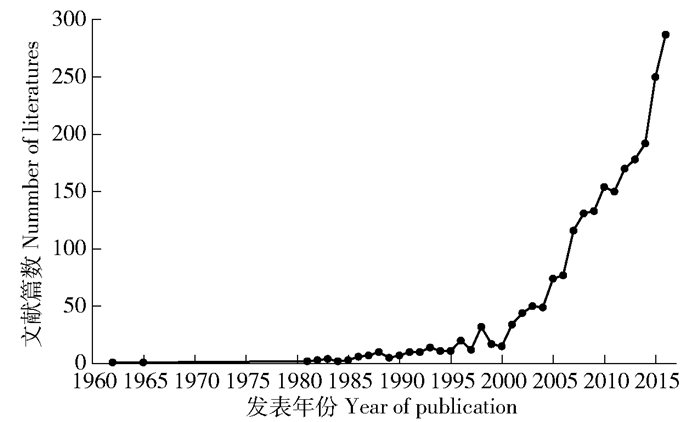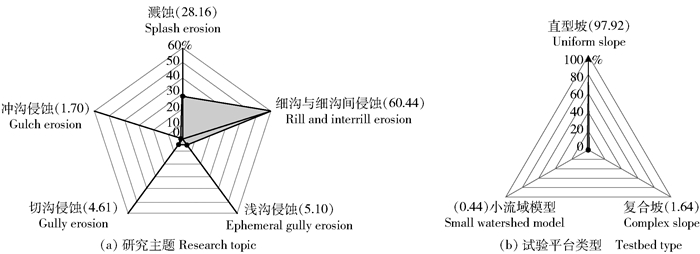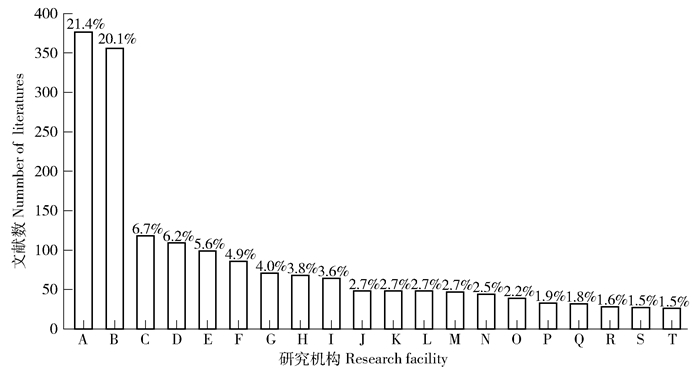-
项目名称
- 国家自然科学基金重点项目"西南黄壤区不同尺度土壤侵蚀与泥沙运移规律耦合关系"(41730748);国家自然科学基金面上项目"东北黑土区冻融作用与水蚀过程耦合机理研究"(41471224)
-
第一作者简介
- 柯奇画(1993-), 女, 硕士研究生。主要研究方向:土壤资源利用与保护。E-mail:qhke@mail.bnu.edu.cn
-
通信作者简介
- 张科利(1962-), 男, 教授, 博士生导师。主要研究方向:土壤侵蚀。E-mail:keli@bnu.edu.cn
-
文章历史
-
收稿日期:2017-09-20
修回日期:2018-03-14
野外径流小区观测是土壤侵蚀研究中获取资料的主要途径;但由于每年产流降雨发生的次数有限,加之维护成本昂贵,在现实中又很难获得天然降雨条件下的产流产沙过程资料,所以仅仅依靠径流小区观测来获取大量土壤侵蚀的科研数据存在很大的局限性[1-2]。为弥补野外小区观测方法的不足,20世纪30年代诞生了人工降雨试验方法。与天然降雨观测相比,人工降雨试验一方面便于进行控制条件下的水蚀规律研究,可以获取侵蚀过程资料,另一方面具有可大大加快研究进程、节约大量的人力物力财力的优势[3-4];因此,人工降雨试验已成为水土保持领域重要的研究方法[4-5]。
从20世纪40—50年代开始,国外学者广泛运用人工降雨方法研究水土流失规律,并取得重要成果,如确定土壤可蚀性K值的诺模图就是Wischmeier等基于美国中西部大量的人工降雨试验资料推导而来的[6]。在我国,人工降雨试验应用于土壤侵蚀相关研究始于20世纪60年代[5],许多学者利用室内或野外人工降雨试验进行大量侵蚀相关研究,如坡面侵蚀产沙、径流/入渗、淋溶、土壤养分流失与迁移构成等。笔者运用文献法,对我国运用人工降雨试验进行侵蚀相关研究的文献资料进行统计分析和综述,并针对其中的关键问题提出了今后的解决方向,旨在为把握我国土壤侵蚀模拟试验研究方法提供基础数据,为我国水土保持研究和工作的进步指明方向。
1 我国人工降雨侵蚀相关试验的研究现状在知网、万方、维普等中文数据库以及Web of Science、Elsevier SD、Engineering Village等英文数据库中,通过专业检索的方式对我国利用人工降雨试验进行侵蚀相关研究的文献进行了搜索,检索截止日期为2017年12月1日。最终搜索到中国作者发表的相关研究论文2 500余篇,具体有自1962年以来的1 800余篇中文研究论文及自1982年以来的近700篇英文研究论文。本文从时间历程、空间分布、研究主题、试验平台、降雨机类型、试验方法、研究机构及其地区分布等方面对这些文献进行分类统计,全面介绍我国人工降雨试验在侵蚀相关研究中的发展状况。
1.1 时间历程人工降雨试验在我国起步于20世纪60—70年代,80年代逐步成熟,新世纪后进入快速发展阶段。根据发表年份对现有相关文献进行统计,得到我国运用人工降雨试验进行侵蚀相关研究的文献数量随时间的变化过程(图 1)。

|
图 1 中国人工降雨侵蚀相关试验研究的文献数量随时间的变化过程 Figure 1 Time-varying process of literatures in erosion-related researches by rainfall simulation experiments in China |
我国最早应用人工降雨进行水土保持研究的文章[7]发表于1962年,此后的人工降雨试验研究大致可分为1962—1979、1980—1999和2000至今3个阶段。在早期(1962—1979年)阶段,只有零星的2篇相关中文研究论文发表于60年代[7-8],年均文献产出不足1篇,人工降雨试验相关研究发展极其缓慢;在1980—1999年期间,年均文献产出约9篇,人工降雨试验相关研究发展开始呈上升趋势,开始有中国作者在外文期刊发表相关研究论文,最早的一篇是Chong等于1986年发表的《Relationship between the runoff curve number and hydrologic soil properties》[9];进入21世纪以来(2000—2016年),人工降雨试验相关研究迅速发展,年均文献产出近124篇,其中2010—2016年间年均文献产出更是高达197篇。
1.2 空间分布按照水土保持一级区划对现有相关文献进行分区统计,可以得到我国人工降雨试验的空间分布概况(表 1)。人工降雨侵蚀相关试验在西北黄土高原区应用最多,发表的论文数量几乎占到所有相关论文的一半。其次是南方红壤区和西南紫色土区,其中南方红壤区占23.4%,西南紫色土区占13.6%。在西南岩溶区、东北黑土区、北方土石山区、北方风沙区开展的相关研究较少,青藏高原区则是研究空白区。从土壤类型来看,目前我国人工降雨侵蚀相关试验所用的土壤类型以黄土、红壤、紫色土、黑土、石灰土为主,其中用于黄土侵蚀规律研究的最多。
| 表 1 中国人工降雨侵蚀相关试验研究区的空间分布概况 Table 1 Spatial distribution of study areas in erosion-related researches by rainfall simulation experiments in China |
纵观以往相关研究,人工降雨试验可分为野外原位试验和室内模拟试验2大类,其中室内模拟试验又可分为原型试验和模型试验。人工降雨原型试验保持了侵蚀坡面原有的几何形态,通常用于研究溅蚀、细沟与细沟间侵蚀相关研究中;而人工降雨模型试验则通过将较大的原型进行概化和缩小,在模型上进行试验,通常应用于浅沟、切沟和冲沟侵蚀的相关研究中。人工降雨模型试验通常只是缩小了地形,而无法解决雨滴大小分布[10]和土壤结构的缩小问题。由于无法遵循3要素等比例相似的原理,大多涉及浅沟、切沟和冲沟侵蚀的人工降雨模型试验在研究方法上是不可行的。
按照研究主题进行统计,绝大部分人工降雨试验应用于细沟与细沟间侵蚀、雨滴溅蚀研究,相关研究论文占比分别超过60%和近30%;运用缩比尺模型开展浅沟、切沟和冲沟侵蚀的研究只占少数(图 2(a))。关于浅沟、切沟和冲沟侵蚀的人工降雨模型试验通常是在大雨强、陡坡度或结合冲刷试验的条件下进行[11-15],其中浅沟、切沟侵蚀又多在沟蚀发育过程或侵蚀方式演变过程的相关研究中同时出现[16-19],而冲沟侵蚀则多出现在泥石流相关研究中[20-23]。

|
图 2 我国人工降雨侵蚀相关试验中不同研究主题和试验坡型的分布概况 Figure 2 Subjects and slope types in erosion-related researches by simulated rainfall experiments in China |
根据复杂程度,可将人工降雨试验中的平台类型分为直型坡(单一坡向单一坡度)、复合坡(单一坡向多个坡度)和小流域模型(多个坡向多个坡度组合)这3种。绝大多数模拟侵蚀过程的人工降雨试验所用平台为直型坡,应用率近98%;其次是复合坡,但应用率只有1.64%;模拟地形复杂的小流域模型最少,只有0.44%(图 2(b))。在试验平台为复合坡的研究中:近一半是关于黄土高原坡沟系统的研究,具体是关于坡沟系统的径流泥沙过程、时空分布以及降雨、植被对坡沟系统产流产沙的影响等方面的研究[24-27];也存在以雏形沟、凹凸型坡为平台的复合坡人工降雨试验研究[28-30]。直型坡是人工降雨试验研究中的基本坡型,即使在野外开展的原位试验,也是尽可能地将试验坡面修整成直型。目前我国直型坡的人工降雨试验研究中,坡长最长可达40 m,分别有20世纪90年代蔡强国等人在马场沟小流域内40 m坡长上进行的野外人工降雨试验[31]和21世纪初刘纪根等人在8 m长的土槽上通过调节上方汇水进行当量坡长为40 m的室内人工降雨试验[32];坡度超过30°的人工降雨试验多在室内通过可变坡度土槽或边坡模型进行,其中坡度最陡可达45°[33-35]。
1.4 人工模拟降雨装置人工模拟降雨装置应用于土壤侵蚀相关研究的历史最早可以追溯到20世纪30年代的美国,当时使用结构简易的喷壶进行人工降雨试验[36];从20世纪50年代开始,人工模拟降雨装置的研制在世界范围内受到了广泛重视,不同类型的人工模拟降雨装置陆续被研制出来[3]。从20世纪50年代后期起,我国开始引进并研制各种类型的人工模拟降雨装置开展室内和野外试验[3]。据西班牙学者Cerdá统计,1938—1999年期间不包括中国在内的世界各国共发明改造229种人工模拟降雨装置[37]。在众多的人工模拟降雨装置中,根据雨滴是否具有初速度可分为滴水式和喷水式2大类[3, 38-39],根据雨滴产生原理的不同可分为喷嘴式、管网式、针管式和悬线式4大类[39-40]。其中:喷嘴式和管网式都属于喷水式,所产生的雨滴具有一定的初始速度,且雨滴大小分布不一,较符合天然降雨实际情况;针管式和悬线式则属于滴水式,产生的雨滴初速度几乎为0,雨滴大小比较均匀和稳定,与天然降雨有一定差别。
根据相关论文和发明专利统计,我国在1959—2017年期间共有近80种用于侵蚀相关研究的降雨装置被研制出来,其中适用于室内的占45%,适用于野外条件的占35%,实验室和野外均适用的占20%。由表 2可知,我国研制的降雨机以喷水式为主,滴水式降雨机种类和数量均较少。喷嘴式降雨机种类和数量最多,占65%;其次是针管式和管网式,分别占23%和10%;悬线式则仅有清华大学的邵学军等[41]于2004年研制的一例。关于降雨装置的应用,采用最为广泛的是静止喷嘴式中的侧喷式和下喷式降雨机,两者相关文献均占37%左右;其次是振动针管式、摆动下喷式和管网下喷式,相关文献分别占11%、7%和5%左右;其他开发不久、较为新颖的降雨装置类型的应用几乎都处于空白状态。模拟降雨装置种类繁多,在进行人工降雨试验时,根据研究目的、试验条件选择合适的降雨机尤为重要。
| 表 2 我国侵蚀相关人工模拟降雨装置的研制和应用概况 Table 2 Development and application of erosion-related rainulators in China |
根据试验条件,可将人工降雨试验大体可分为野外原位试验和室内模拟试验2种类型。据统计,我国的人工降雨侵蚀相关试验中,约60%是在室内进行的,只有40%是在野外原位状态下完成的。野外原位试验一般以面积较大的径流小区或者自然土坡为试验平台,土壤处于原位自然状态,只是通过模拟降雨开展试验。室内模拟试验一般以溅蚀杯(盘)、变坡土槽、复合坡模型或小流域模型为试验平台,降雨是人工模拟状态,试验土壤也经过了不同程度的人为干扰。对于试验土壤的处理,一部分研究选择将土壤过筛(一般10 mm)以除去杂草和石块[42-44],土壤结构受到一定破坏,一部分研究则采取不研磨不过筛处理,仅打碎大块的土块或用手将大土块按自然节理分成小块,尽量保持土壤的自然结构状态[45-47]。对于土槽试验中的填土过程,也有多种处理方式:有些研究将土样混匀后分层(一般每次装土5 cm厚)填到土槽中[48],有些研究则是在野外分层取样后回室内按野外土层顺序将土样装填至土槽内,保留了土壤原有的剖面结构[49];有些试验直接将土样填入底部无孔的土槽中[50],有些试验为了保证土壤水自由入渗,或在无孔土槽中先铺上一层细沙或当地土壤然后在其上填入试验土壤[42, 46],或在底板有孔洞的土槽底部先铺设一层纱布再填入土料[51-52];较为严谨的研究还考虑到了分层效应和边界效应的影响,即在填装上层土料之前抓毛或耙松下层土壤表面以防土层之间出现分层现象[53-54],在土槽边壁粘上一层沙粒[44]或压实边壁处土壤[55]来避免边壁效应引起的沟蚀现象。对于人工降雨侵蚀试验来说,保证坡面尽量接近自然状态,关乎试验结果的实用价值。
1.6 研究机构及其地区分布目前,我国共有近400所高校、研究院所、试验站和行政管理单位等各类机构参与到人工降雨侵蚀相关试验研究中。早期(1962—1999年),我国人工降雨试验研究以研究院所为主导,其次是高校和试验站,当时尚无行政单位参与;如今,我国人工降雨试验研究以高校为研究主力,其后依次是相关研究院所、试验站和行政管理单位。根据发表成果数量的大小排序,得到我国人工降雨侵蚀相关试验研究的前20强单位(图 3)。按照发表成果数量排名来看,前5强单位依次是:中国科学院水利部水土保持研究所,西北农林科技大学,西安理工大学,中科院地理科学与资源研究所,华中农业大学。前20强研究单位发表的文献占所有相关文献的61%,其中高校占40%。

|
A:中科院水利部水土保持研究所; B:西北农林科技大学; C:西安理工大学; D:中科院地理科学与资源研究所; E:华中农业大学; F:北京林业大学; G:中国农业大学; H:北京师范大学; I:西南大学; J:四川农业大学; K:沈阳农业大学; L:浙江大学; M:长江科学院; N:中国科学院大学; O:黄河水利科学研究院; P:贵州大学; Q:中国科学院水利部成都山地灾害与环境研究所; R:福建农林大学; S:山西农业大学; T:兰州大学 A: Institute of Soil and Water Conservation, CAS. B: Northwest Sci-Tech University of Agriculture and Forestry. C: Xi′an University of Technology. D: Institute of Geographic Sciences and Natural Resources Research, CAS. E: Huazhong Agricultural University. F: Beijing Forestry University. G: China Agricultural University. H: Beijing Normal University. I: Southwest University. J: Sichuan Agricultural University. K: Shenyang Agricultural University. L: Zhejiang University. M: Changjiang River Scientific Research Institute. N: University of Chinese Academy of Sciences. O: Yellow River Institute of Hydraulic Research. P: Guizhou University. Q: Institute of Mountain Hazards and Environment, CAS. R: Fujian Agriculture and Forestry University. S: Shanxi Agricultural University. T: Lanzhou University 图 3 我国人工降雨侵蚀相关试验研究前20强单位的文献发表情况 Figure 3 Publications of top 20 facilities in erosion-related researches by simulated rainfall experiments in China |
根据我国一级行政区划,对全国各地利用人工降雨试验进行侵蚀相关研究的机构及其发表文献数量进行分区统计,得到表 3。可明显看出我国开展人工降雨侵蚀相关试验的研究单位集中于北京,文献发表则集中于陕西,单位机构发表成果数量以陕西最多。
| 表 3 我国人工降雨侵蚀相关试验研究机构和文献的地区分布概况 Table 3 Regional distribution of facilities and literatures in erosion-related researches by simulated rainfall experiments in China |
利用人工降雨试验进行侵蚀相关研究在我国取得了丰富成果,使用的模拟降雨装置类型各式各样,研究方法也多种多样,不同研究结果之间的可比性问题和研究的规范化问题尚需探讨。1)目前大部分的人工降雨侵蚀相关试验对降雨因素的量化仅停留于降雨量和雨强上,忽略了各降雨特性中降雨侵蚀力EI30与土壤侵蚀量相关最为密切的客观规律,也没有考虑到不同类型降雨机下雨强与降雨动能对应关系不同的事实,导致利用不同类型降雨机进行相似试验的研究结果之间可比性差,这大大削弱了人工降雨试验水沙结果的实用价值和推广价值。2)很多研究由于模拟方法的不统一、不合理和不规范,使得相同条件下不同人工降雨试验研究之间、人工降雨试验和原位天然降雨情况之间,在水沙结果上存在不同程度的明显差别,导致试验结果的代表性和可推广性变差。
针对以上关键问题,谈一下我国水土保持领域中人工降雨试验方法未来的前进方向。1)今后研究中,需弄清不同类型降雨机所产生单位降雨动能随雨强的变化规律,将降雨因素对侵蚀的影响统一落到降雨侵蚀力上,消除由于降雨机类型不同带来的设备误差。2)急需提出一套人工降雨试验的操作规范,尽量保证试验土壤和坡面状态接近野外自然情况,减少因试验方法不同带来的误差。3)关于缩比尺模型试验方法在土壤侵蚀研究中的应用,仍然存在各要素缩小尺度不协调的现状,其合理性和科学性尚存在问题。
| [1] |
张光辉, 刘宝元, 李平康. 槽式人工模拟降雨机的工作原理与特性[J].
水土保持通报, 2007, 27(6): 56.
ZHANG Guanghui, LIU Baoyuan, LI Pingkang. Principles and properties of artificial trough rainfall simulator[J]. Bulletin of Soil and Water Conservation, 2007, 27(6): 56. |
| [2] |
谢云, 林小鹃, 刘英娜, 等. 槽式摆喷头下喷式人工模拟降雨机的雨强及其空间分布率定[J].
水土保持通报, 2008, 28(4): 2.
XIE Yun, LIN Xiaojuan, LIU Yingna, et al. Calibration of simulated rainfall intensityand its spatial distribution for trough rainfall simulator[J]. Bulletin of Soil and Water Conservation, 2008, 28(4): 2. |
| [3] |
陈文亮, 王占礼. 国内外人工模拟降雨装置综述[J].
水土保持学报, 1990, 4(1): 61.
CHEN Wenliang, WANG Zhanli. The review of simulated rainfall equipments at home and abroad[J]. Journal of Soil and Water Conservation, 1990, 4(1): 61. |
| [4] |
王洁, 胡少伟, 周跃. 人工模拟降雨装置在水土保持方面的应用[J].
水土保持研究, 2005, 12(4): 188.
WANG Jie, HU Shaowei, ZHOU Yue. Application of artificial simulation of rainfall devices to soil and water conservation[J]. Research of Soil and Water Conservation, 2005, 12(4): 188. |
| [5] |
赵志进, 李桂英. 人工模拟降雨机具和方法的发展研究与展望[J].
中国水土保持, 1989(5): 31.
ZHAO Zhijin, LI Guiying. Development research and prospects of machinery and methods of simulated rainfall[J]. Soil and Water Conservation In China, 1989(5): 31. |
| [6] |
刘宝元, 谢云, 张科利, 等.
土壤侵蚀预报模型[M]. 北京: 中国科学技术出版社, 2001: 72.
LIU Baoyuan, XIE Yun, ZHANG Keli, et al. Soil loss prediction model[M]. Beijing: China Science and Technology Press, 2001: 72. |
| [7] |
徐在庸, 胡玉山. 坡面径流的试验研究[J].
水利学报, 1962, 6(4): 1.
XU Zaiyong, HU Yushan. The experimental research of the overland runoff[J]. Journal of Hydraulic Engineering, 1962, 6(4): 1. |
| [8] |
刘昌明, 洪宝鑫, 曾明煊, 等. 黄土高原暴雨径流预报关系初步实验研究[J].
科学通报, 1965, 10(2): 158.
LIU Changming, HONG Baoxin, ZENG Mingxuan, et al. Preliminary experimental study on storm runoff forecast in the Loess Plateau[J]. Chinese Science Bulletin, 1965, 10(2): 158. |
| [9] |
CHONG S K, TENG T M. Relationship between the runoff curve number and hydrologic soil properties[J].
Journal of Hydrology, 1986, 84(1/2): 1.
|
| [10] |
雷阿林, 唐克丽. 土壤侵蚀模型试验中的降雨相似及其实现[J].
科学通报, 1995, 40(21): 2005.
LEI A-lin, TANG Keli. Rainfall similarity in soil erosion modeling test and its implementation[J]. Chinese Science Bulletin, 1995, 40(21): 2005. |
| [11] |
郭明明, 王文龙, 李建明, 等. 黄土区坡耕地耕作对浅沟径流产沙及其形态发育特征的影响[J].
农业工程学报, 2015, 31(15): 114.
GUO Mingming, WANG Wenlong, LI Jianming, et al. Effect of tillage on runoff and sediment yields and morphology development characteristic of ephemeral gully in Loessial Region[J]. Transactions of the CSAE, 2015, 31(15): 114. DOI: 10.11975/j.issn.1002-6819.2015.15.016. |
| [12] |
龚家国, 周祖昊, 贾仰文, 等. 黄土区浅沟侵蚀沟槽发育及其水流水力学基本特性模拟实验研究[J].
水土保持学报, 2010, 24(5): 92.
GONG Jiaguo, ZHOU Zuhao, JIA Yangwen, et al. Simulation experiment of ephemeral gully erosion on basis hydraulics parameters of concentrated flow and erosion morphology in loess area[J]. Journal of Soil and Water Conservation, 2010, 24(5): 92. |
| [13] |
武敏, 郑粉莉, 黄斌. 黄土坡面汇流汇沙对浅沟侵蚀影响的试验研究[J].
水土保持研究, 2004, 11(4): 74.
WU Min, ZHENG Fenli, HUANG Bin. Experimental study on upslope runoff effects on ephemeral gully erosion processes at loessial hillslope[J]. Research of Soil and Water Conservation, 2004, 11(4): 74. |
| [14] |
LIN Jinshi, ZHU Gaolin, WEI Jia, et al. Mulching effects on erosion from steep slopes and sediment particle size distributions of gully colluvial deposits[J].
Catena, 2018, 160: 57.
DOI: 10.1016/j.catena.2017.09.003. |
| [15] |
郑海金, 杨洁, 张洪江, 等. 南方红壤区农田道路强降雨侵蚀过程试验[J].
农业机械学报, 2012, 43(9): 85.
ZHENG Haijin, YANG Jie, ZHANG Hongjiang, et al. Field simulated experiment on erosion processes of different farm roads under a heavy rain in Red Soil Region[J]. Transactions of the CSAM, 2012, 43(9): 85. |
| [16] |
陈吉强. 黄土坡面沟蚀发育过程的模拟试验研究[D]. 陕西杨凌: 西北农林科技大学, 2010: 1.
CHEN Jiqiang. An experimental study on loessial hill slope gully erosion development process[D]. Yangling, Shaanxi: Northwest A & F University, 2010: 1. http://cdmd.cnki.com.cn/Article/CDMD-10712-2010149009.htm |
| [17] |
张新和, 郑粉莉, 张鹏, 等. 黄土坡面侵蚀方式演变过程中汇水坡长的侵蚀产沙作用分析[J].
干旱地区农业研究, 2007, 25(6): 126.
ZHANG Xinhe, ZHENG Fenli, ZHANG Peng, et al. Contribution of upstream slope length to loessial hillslope erosion and sediment during erosion pattern evolution process[J]. Agricultural Research in the Arid Areas, 2007, 25(6): 126. |
| [18] |
王文龙, 雷阿林, 李占斌, 等. 土壤侵蚀链内细沟浅沟切沟流动力机制研究[J].
水科学进展, 2003, 14(4): 471.
WANG Wenlong, LEI A-lin, LI Zhanbin, et al. Study on dynamic mechanism of rills, shallow furrows and gully in the soil erosion chain[J]. Advances in Water Science, 2003, 14(4): 471. |
| [19] |
肖培青, 郑粉莉, 汪晓勇, 等. 黄土坡面侵蚀方式演变与侵蚀产沙过程试验研究[J].
水土保持学报, 2008, 22(1): 24.
XIAO Peiqing, ZHENG Fenli, WANG Xiaoyong, et al. Experimental study on erosion pattern evolvement and sediment process on loessal hillslopes[J]. Journal of Soil and Water Conservation, 2008, 22(1): 24. |
| [20] |
张丽萍, 唐克丽, 张平仓, 等. 泥石流源地松散体起动人工降雨模拟及放水冲刷实验[J].
山地学报, 2016, 17(1): 45.
ZHANG Liping, TANG Keli, ZHANG Pingcang, et al. Experiments of artificial simulation rainfall and setting water initiating accumulated material in debris flow origin place[J]. Journal of Mountain Science, 2016, 17(1): 45. |
| [21] |
高冰, 周健, 张姣. 泥石流启动过程中水土作用机制的宏细观分析[J].
岩石力学与工程学报, 2011, 30(12): 2567.
GAO Bing, ZHOU Jian, ZHANG Jiao. Macro-meso analysis of water-soil interaction mechanism of debris flow starting process[J]. Chinese Journal of Rock Mechanics and Engineering, 2011, 30(12): 2567. |
| [22] |
孙东彦, 陈剑平, 马玉飞, 等. 基于人工降雨的天津盘龙谷泥石流起动特征[J].
东北大学学报(自然科学版), 2016, 37(11): 1625.
SUN Dongyan, CHEN Jianping, MA Yufei, et al. Initiation of debris flow in Tianjin Panlonggu based on artificial rainfall[J]. Journal of Northeastern University(Natural Science), 2016, 37(11): 1625. DOI: 10.3969/j.issn.1005-3026.2016.11.022. |
| [23] |
倪化勇. 人工降雨条件下冲沟型泥石流起动试验研究[J].
工程地质学报, 2015, 23(1): 111.
Ni Huayong. Field experiments for groove-type debris flow initiation with artificial rainfall[J]. Journal of Engineering Geology, 2015, 23(1): 111. |
| [24] |
王文龙, 雷阿林, 李占斌, 等. 黄土区不同地貌部位径流泥沙空间分布试验研究[J].
农业工程学报, 2003, 19(4): 40.
WANG Wenlong, LEI A-lin, LI Zhanbin, et al. Spatial distribution of runoff and sediment on the different topography positions of vertical belts in Loess Region of hilly[J]. Transactions of the CSAE, 2003, 19(4): 40. |
| [25] |
余叔同. 黄土丘陵区坡沟系统沟蚀发育过程模拟与可视化[D]. 陕西杨凌: 西北农林科技大学, 2010: 1.
YU Shutong. Simulation and visullization of gully erosion development process in hillyslope-gully system of loess hilly region[D]. Yangling, Shaanxi: Northwest A & F University, 2010: 1. http://cdmd.cnki.com.cn/Article/CDMD-10712-2010149191.htm |
| [26] |
范东明, 吴卿, 李志萍, 等. 基于模拟降雨的坡沟系统侵蚀产沙时空分布特征研究[J].
中国水土保持, 2016(3): 43.
FAN Dongming, WU Qing, LI Zhiping, et al. Study on spatial and temporal distribution of soil erosion and sediment yield based on simulated rainfall in slope-gully system[J]. Soil and Water Conservation in China, 2016(3): 43. |
| [27] |
李聪. 植被格局对坡沟系统侵蚀输沙过程调控作用试验研究[D]. 西安: 西安理工大学, 2015: 1.
LI Cong. Experimental study of the regulatory effect of vegetation patterns on the soil erosion on the slope-gully system[D]. Xi'an: Xi'an University of Technology, 2015: 1. http://www.wanfangdata.com.cn/details/detail.do?_type=degree&id=D699904 |
| [28] |
郑粉莉, 武敏, 张玉斌, 等. 黄土陡坡裸露坡耕地浅沟发育过程研究[J].
地理科学, 2006, 26(4): 438.
ZHENG Fenli, WU Min, ZHANG Yubin, et al. Ephemeral gully development process at loess steep hillslope[J]. Scientia Geographica Sinica, 2006, 26(4): 438. |
| [29] |
杨丽娜, 范昊明, 郭成久, 等. 不同坡形坡面侵蚀规律试验研究[J].
水土保持研究, 2007, 14(4): 237.
YANG Lina, FAN Haoming, GUO Chengjiu, et al. Experimental study of soil erosion in different slopes[J]. Research of Soil and Water Conservation, 2007, 14(4): 237. |
| [30] |
于晓杰, 魏勇明. 不同坡形坡面侵蚀产沙过程的影响研究[J].
水土保持研究, 2010, 17(1): 97.
YU Xiaojie, WEI Yongming. Study on soil erosion characters in different slopes[J]. Research of Soil and Water Conservation, 2010, 17(1): 97. |
| [31] |
蔡强国. 坡长对坡耕地侵蚀产沙过程的影响[J].
云南地理环境研究, 1998(1): 35.
CAI Qiangguo. Effects of slope length on soil erosion and sediment yield of slope cropland[J]. Yunnan Geographic Environment Research, 1998(1): 35. |
| [32] |
刘纪根, 雷廷武, 潘英华, 等. 陡坡耕地施加PAM侵蚀产沙规律及临界坡长的试验研究[J].
土壤学报, 2003, 40(4): 504.
LIU Jigen, LEI Tingwu, PAN Yinghua, et al. Effect of polyacrylamide on sediment loss and critical slope length of steep cultivated slope land[J]. Acta Pedologica Sinica, 2003, 40(4): 504. DOI: 10.11766/trxb200109150404. |
| [33] |
李凤英, 何小武, 肖青亮, 等. 急陡坡土壤侵蚀试验研究[J].
水土保持学报, 2009, 23(6): 38.
LI Fengying, HE Xiaowu, XIAO Qingliang, et al. Research of soil erosion on very steep slope[J]. Journal of Soil and Water Conservation, 2009, 23(6): 38. |
| [34] |
张涛, 李雄峰, 陈鹏宇, 等. 矿山边坡水土流失过程室内模型试验[J].
低温建筑技术, 2016, 38(1): 91.
ZHANG Tao, LI Xiongfeng, CHEN Pengyu, et al. Indoor model test of soil erosion process in mine slope[J]. Low Temperature Architecture Technology, 2016, 38(1): 91. |
| [35] |
邹小军. 红壤区急陡坡条件下土壤侵蚀研究[D]. 南昌: 江西农业大学, 2016: 9.
ZOU Xiaojun. Study of soil erosion on very steep slope in Red Soil Region[J]. Nanchang:Jiangxi Agricultural University, 2016:9. http://cdmd.cnki.com.cn/Article/CDMD-10410-1016280379.htm |
| [36] |
DULEY F L, HAYS O E. Determining the effect of the degree of slope on runoff and soil erosion[J].
Journal of Agricultral Research, 1932, 45(6): 351.
|
| [37] |
CERDÁ A. A review of the rainfall simulators and its applications to the Geomorphology[J].
Cuadernos De Investigación Geográfica, 1999(25): 60.
|
| [38] |
LAL R. Soil Erosion Research Methods[M]//MEYER L D. Rainfall simulators for soil erosion research. Soil and Water Conservation Society. St. Lucie Press, 1994: 86.
|
| [39] |
程飞, 徐向舟, 高吉惠, 等. 用于土壤侵蚀试验的降雨模拟器研究进展[J].
中国水土保持科学, 2008, 6(2): 107.
CHENG Fei, XU Xiangzhou, GAO Jihui, et al. Advance of research on the rainfall simulators for soil erosion[J]. Science of Soil and Water Conservation, 2008, 6(2): 107. |
| [40] |
代肖, 张海涛, 周大迈, 等. 人工模拟降雨装置及其应用介绍[J].
中国水土保持, 2012(12): 52.
DAI Xiao, ZHANG Haitao, ZHOU Daimai, et al. Introduction of artificial rainfall simulator and its application[J]. Soil and Water Conservation in China, 2012(12): 52. DOI: 10.3969/j.issn.1000-0941.2012.12.023. |
| [41] |
邵学军, 胡慧武. 坡面降雨试验装置设计[J].
实验技术与管理, 2004, 21(1): 39.
SHAO Xuejun, HU Huiwu. Design of rainfall test equipment on slope[J]. Experimental Technology and Management, 2004, 21(1): 39. |
| [42] |
孔亚平, 张科利, 唐克丽. 坡长对侵蚀产沙过程影响的模拟研究[J].
水土保持学报, 2001, 15(2): 18.
KONG Yaping, ZHANG Keli, TANG Keli. Impacts of slope length on soil erosion process under simulated rainfall[J]. Journal of Soil and Water Conservation, 2001, 15(2): 18. |
| [43] |
刘俊体, 孙莉英, 张学培, 等. 2次降雨条件下不同土壤细沟侵蚀分析[J].
中国水土保持科学, 2013, 11(4): 23.
LIU Junzhi, SUN Liying, ZHANG Xuepei, et al. Analysis of two kinds soil rill evolution under the secondary rainfall[J]. Science of Soil and Water Conservation, 2013, 11(4): 23. |
| [44] |
肖培青, 姚文艺, 申震洲, 等. 草被减流减沙效应及其力学机制分析[J].
中国水土保持科学, 2010, 8(2): 16.
XIAO Peiqing, YAO Wenyi, SHEN Zhenzhou, et al. Reduction effects of grass on runoff and sediment and its mechanical mechanism[J]. Science of Soil and Water Conservation, 2010, 8(2): 16. |
| [45] |
边锋, 郑粉莉, 徐锡蒙, 等. 东北黑土区顺坡垄作和无垄作坡面侵蚀过程对比[J].
水土保持通报, 2016, 36(1): 12.
BIAN Feng, ZHENG Fenli, Xu Ximeng, et al. Comparison of soil erosion process between longitudinal ridge slope and non-ridge slope in Mollisol Region of Northeast China[J]. Bulletin of Soil and Water Conservation, 2016, 36(1): 12. |
| [46] |
安娟, 卢嘉, 郑粉莉, 等. 不同地表条件下黑土区坡耕地侵蚀过程中土壤团聚体迁移[J].
水土保持学报, 2011, 25(6): 101.
AN Juan, LU Jia, ZHENG Fenli, et al. Soil aggregate transport during soil erosion process under different soil surface conditions on black soil slope farmland[J]. Journal of Soil and Water Conservation, 2011, 25(6): 101. |
| [47] |
刘和平. 坡长对土壤可蚀性K值测定的影响[D]. 北京: 北京师范大学, 2008: 13.
LIU Heping. The effect of plot length on measurement of soil erodibility[D]. Beijing: Beijing Normal University, 2008: 13. http://cdmd.cnki.com.cn/Article/CDMD-10027-2008094967.htm |
| [48] |
刘淼, 杨明义, 张风宝. 黄土坡面细沟发育及细沟与细沟间侵蚀比率研究[J].
水土保持学报, 2015, 29(1): 13.
LIU Miao, YANG Mingyi, ZHANG Fengbao. Research on rill development and proportions of interrill and rill erosion from loess soil slopes[J]. Journal of Soil and Water Conservation, 2015, 29(1): 13. |
| [49] |
付兴涛, 姚璟. 降雨条件下坡长对陡坡产流产沙过程影响的模拟试验研究[J].
水土保持学报, 2015, 29(5): 21.
FU Xingtao, YAO Jing. Simulation experiment on the impact of slope length on steep slope runoff and sediment process under rainfall conditions[J]. Journal of Soil and Water Conservation, 2015, 29(5): 21. |
| [50] |
孔刚, 王全九, 樊军, 等. 前期含水量对坡面降雨产流和土壤化学物质流失影响研究[J].
土壤通报, 2008, 39(6): 1395.
KONG Gang, WANG Quanjiu, FAN Jun, et al. Effects of initial water content on hillslope rainfall in filtration and soil nutrient loss[J]. Chinese Journal of Soil Science, 2008, 39(6): 1395. |
| [51] |
王添, 任宗萍, 李鹏, 等. 模拟降雨条件下坡度与地表糙度对径流产沙的影响[J].
水土保持学报, 2016, 30(6): 2.
WANG Tian, REN Zongping, LI Peng, et al. Effect of slope gradient and surface roughness on runoff and sediment yield under simulated rainfall[J]. Journal of Soil and Water Conservation, 2016, 30(6): 2. |
| [52] |
王辉, 王全九, 邵明安. 人工降雨条件下黄土坡面养分随径流迁移试验[J].
农业工程学报, 2006, 22(6): 39.
WANG Hui, WANG Quanjiu, SHAO Ming-an. Laboratory experiments of soil nutrient transfer in the loess slope with surface runoff during simulated rainfall[J]. Transactions of the CSAE, 2006, 22(6): 39. |
| [53] |
张会茹, 郑粉莉. 不同降雨强度下地面坡度对红壤坡面土壤侵蚀过程的影响[J].
水土保持学报, 2011, 25(3): 41.
ZHANG Huiru, ZHENG Fenli. Effect of slope gradients on erosion from a red soil hillslope under different rainfall intensity[J]. Journal of Soil and Water Conservation, 2011, 25(3): 41. |
| [54] |
盛贺伟, 郑粉莉, 蔡强国, 等. 降雨强度和坡度对粘黄土坡面片蚀的影响[J].
水土保持学报, 2016, 30(6): 14.
SHENG Hewei, ZHENG Fenli, CAI Qiangguo, et al. Effects of rainfall intensity and slope gradient on sheet erosion at the clay loess hillslope[J]. Journal of Soil and Water Conservation, 2016, 30(6): 14. |
| [55] |
钱婧, 张丽萍, 王小云, 等. 人工降雨条件下不同坡长和覆盖度对氮素流失的影响[J].
水土保持学报, 2012, 26(5): 7.
QIAN Jing, ZHANG Liping, WANG Xiaoyun, et al. Effects of different slope length and vegetation coverage on nitrogen loss in sloping land under artificial simulated rainfall[J]. Journal of Soil and Water Conservation, 2012, 26(5): 7. |
 2018, Vol. 16
2018, Vol. 16 
